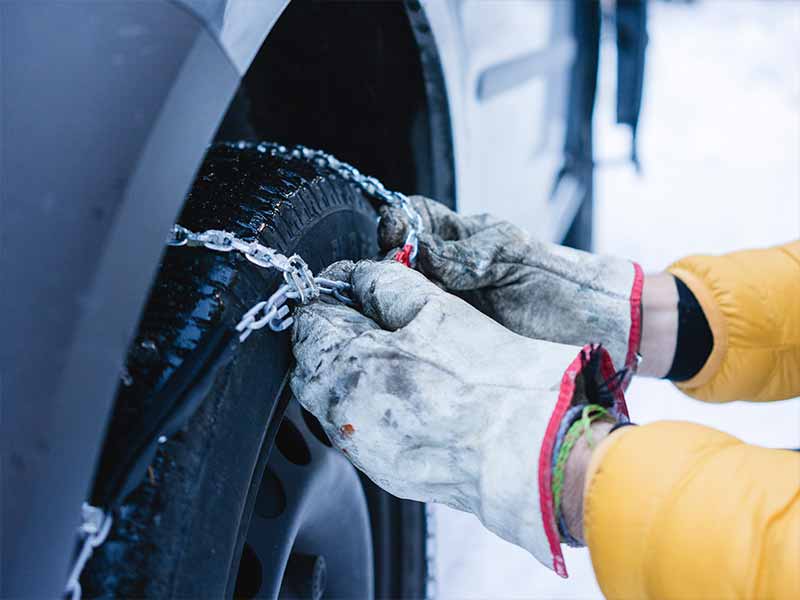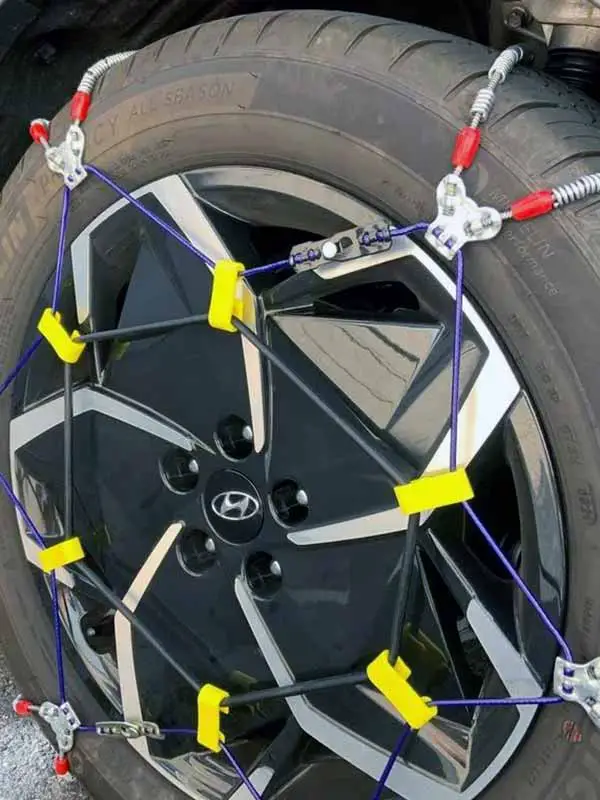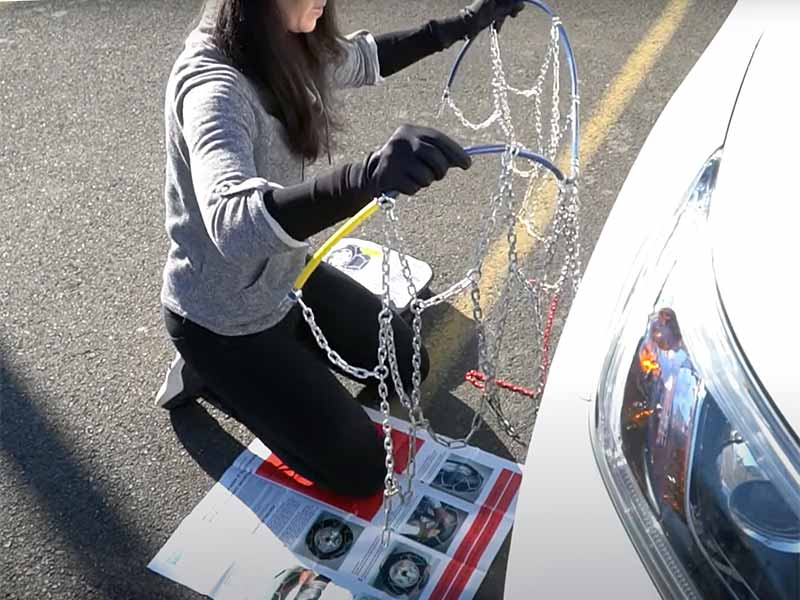Are you stuck with tire chains from a previous vehicle and unsure if they’ll fit your new car or a friend’s truck? Deciphering the size of tire chains can be perplexing, especially when you’re dealing with chains meant for another vehicle.
But worry not! I’ll guide you through determining the size of your tire chains with ease.
How To Tell What Size Chains You Have
Determining the size of your tire chains involves understanding their length and width, typically measured in links and cross links, ensuring compatibility with your vehicle’s current tire size.
In this article, I’ll walk you through the process of determining the size of tire chains you currently possess. You’ll learn how to measure chain length by counting links, assess their compatibility, and ensure a proper fit on your vehicle or a friend’s car or truck.
Understanding Tire Size Specifications
Snow chains are designed to fit a range of tire sizes. To be able to understand what tires your chains will fit, you’ll need a basic understanding of tire size.
Let’s break down the three main numbers on your tire’s sidewall that signify vital aspects of your tire’s size: the aspect ratio, section width, and wheel diameter.
Aspect Ratio – Height of the Sidewall
The aspect ratio is denoted by the second number in the tire size code, such as the ’65’ in P215/65R15. This figure represents the sidewall’s height as a percentage of the tire’s width.
- Understanding the Percentage: If the aspect ratio is 65, it means the sidewall’s height is 65% of the tire’s width. A higher aspect ratio indicates a taller sidewall, while a lower ratio signifies a shorter sidewall.
- Impact on Ride Comfort: Tires with a higher aspect ratio tend to offer a smoother and more cushioned ride due to increased sidewall flexibility. On the other hand, lower aspect ratios often enhance handling and responsiveness but may compromise comfort.
Section Width – Width of the Tire’s Tread
The first number in the tire size, like ‘215’ in P215/65R15, indicates the tire’s section width in millimeters.
- Measuring the Width: This number represents the distance between the sidewalls of the tire, showcasing the tire’s overall width from one side to the other when properly mounted on a specified width rim.
- Impact on Handling: Wider tires often provide more traction and grip, particularly during cornering. However, they might impact fuel efficiency and could be more susceptible to hydroplaning in wet conditions.
Wheel Diameter – Size of the Wheel
The last number in the tire size code, for instance, ’15’ in P215/65R15, signifies the diameter of the wheel the tire is designed to fit, measured in inches.
- Fitting the Wheel: This number ensures the tire matches the rim diameter on which it’s mounted. Installing a tire with a different wheel diameter could compromise vehicle performance and safety.
- Performance and Comfort: Larger diameter wheels might offer improved handling and a sportier appearance, but they could lead to a stiffer ride due to decreased sidewall height.
Determining Chain Size
When it comes to ensuring the perfect fit for your tire chains, accurate measurements are key:
- Length: Measure the length of your tire chains by laying them flat on the ground and extending them end to end. This measurement should match the tire’s circumference.
- Width: Determine the width by measuring across the tire width of the tire chains. It should align with your tire’s width for a secure fit without being too loose or too tight.
Understanding Chain Links
The length and width of tire chains are often determined by the number of links they contain:
- Chain Links: Chains are made of interconnected links, and the number of these links determines the chain’s length. Count the links or check the packaging specifications to confirm the chain’s size.
- Cross Chains: Tire chains also have cross chain links, which are the chains’ horizontal pieces connecting the main chains. These should correspond to the tire’s tread width.
Ensuring Proper Fit
Matching the chain size to your tire size ensures effective usage:
- Proper Length: Chains that are too short won’t fully cover the tire, while chains that are too long might drag or even cause damage to your vehicle.
- Appropriate Width: Chains that are too narrow won’t provide enough coverage and may slip, while those too wide may interfere with the vehicle’s operation or cause damage.
If you’re unsure how many chains you might need for your vehicle, especially considering different drive systems like AWD or 2-wheel drive, you can refer to How Many Snow Chains for AWD or How Many Snow Chains Do I Need for 2-Wheel Drive for tailored advice.

Determining Tire Chain Size by Counting Links
One way to ensure the right fit for tire chains is by counting the number of links. Counting links is a practical method to determine tire chain size. Understanding the link count and length per link is beneficial in selecting the right chains that align with your tire size, ensuring optimal performance and safety during wintry conditions.
I’ll guide you through this straightforward process.
Counting Chain Links
- Measure the Length: Lay out the chain on a flat surface and extend it to its full length. Take note of the entire length from end to end.
- Count the Links: Carefully count the number of individual links that comprise the chain. This count will determine the chain’s size.
Understanding Chain Length
- Link-to-Inch Conversion: In many cases, each link might correspond to a specific length, typically an inch. For example, a chain might have 9 links per foot, meaning 9 links measure 12 inches.
- Calculating Chain Size: Once you’ve counted the links, divide the total length of the chain by the number of links to get the length per link.
Checking Compatibility
- Referencing Manufacturer Guidelines: Consult the manufacturer’s specifications or guidelines. They often provide details on the appropriate chain size based on the number of links for various tire sizes.
- Cross-Referencing with Tire Size: Match the obtained link count and length per link with the recommended chain sizes for your tire dimensions.
Ensuring Accuracy
- Accuracy Matters: Ensure your count is accurate. Even a small mistake in counting links can result in incorrect chain size selection.
- Consider Cross Chain Links: Some chains might have additional cross links that contribute to overall width or length. Account for these when determining the size.

Checking Compatibility
Ensuring you have compatible tire chains for your vehicle is important for safe driving in snow or icy conditions as well as avoiding damage to your car or truck.
Let’s dive into how to do this.
Verifying Compatibility
Before purchasing or installing tire chains, consider these factors for compatibility:
- Manufacturer Guidelines: Always refer to the manufacturer’s guidelines or your vehicle’s manual for recommended tire chain sizes compatible with your tires.
- Clearance and Fit: Check for any obstructions or limitations around your tires and wheel wells that might interfere with the chains’ installation or operation.
Safety Considerations
Mismatched or incompatible tire chains might pose safety risks:
- Tire Damage: Improperly fitted chains can damage tires, wheel wells, or suspension components, leading to costly repairs.
- Driving Performance: Chains that don’t fit properly may affect handling, braking, and overall vehicle performance in wintry conditions.
Special Vehicle Considerations
Different vehicles may have specific requirements:
- AWD or 4WD Vehicles: These vehicles might have limitations on using tire chains due to their drivetrain. Check the manual or manufacturer guidelines for specific recommendations.
- Limited Clearance Vehicles: Some vehicles, particularly those with limited wheel well clearance or low-profile tires, might have constraints on chain usage. Explore alternative options like low-profile chains or snow socks.

Selecting the Right Chains
I understand the significance of choosing the appropriate chains for varying driving conditions. Selecting the right tire chains isn’t just about purchasing any chains that fit your tires. It’s about choosing the chains that optimize safety, performance, and comfort based on your driving conditions and preferences.
Let’s delve into the factors you should consider when selecting the right tire chains for your needs.
Assessing Driving Conditions
Different driving situations demand different types of chains:
- Frequency of Use: Consider how often you’ll be using the chains. Frequent users might opt for more durable, higher-quality chains.
- Snow vs. Ice: Chains designed for snow might differ from those best suited for icy conditions. Choose accordingly based on prevalent weather conditions.
Factors for Selection
Several aspects play a role in the selection process:
- Chain Material: Chains are made from various materials, each with its own advantages. Steel chains offer durability, while composite materials provide lighter weight and flexibility.
- Ease of Installation: Some chains are easier to install than others. Assess your comfort level with installation procedures to choose chains that suit your convenience.
Considering Tire Sidewall Recommendations
Manufacturers often provide recommendations on the types of chains suitable for your tire sidewall:
- Sidewall Strength: Chains exert pressure on the tire sidewall. Check the tire’s specifications or manufacturer guidelines to ensure compatibility without causing damage.
Tailoring Chains to Your Needs
Understanding your driving requirements helps in selecting the most suitable chains:
- Performance Expectations: Chains impact vehicle handling and performance. Choose chains that align with your expectations for comfort, traction, and overall driving experience.
- User Reviews: Exploring user reviews can provide valuable insights into the practical aspects of various chains, aiding in decision-making.
If you’re contemplating the differences between snow tires and chains or need further guidance on making the right selection, explore Snow Tires vs. Chains for a detailed comparison.
Resources
Below are some links you may find helpful when learning about tires
- How to identify tire chain size by number of links – It Still Runs
- How to buy the right tire chains – etrailer
Final Thoughts
Determining the size of tire chains is essential when repurposing them for a different vehicle. By understanding their length, width, and compatibility, you can ensure a safe and secure fit on new tires.
Remember to measure the chain length accurately by counting links and assessing compatibility guidelines. With this knowledge, you’ll confidently repurpose your tire chains for different vehicles, ensuring safety and efficiency.
Good luck and happy motoring.





